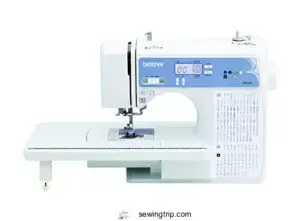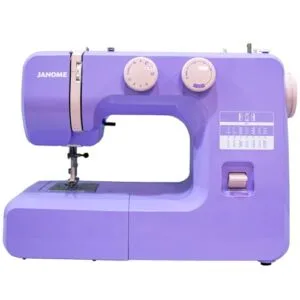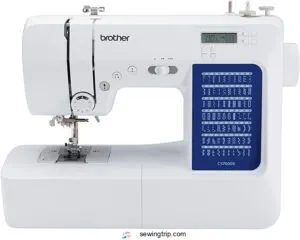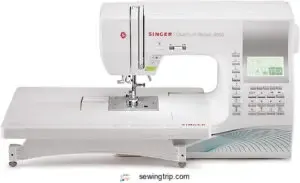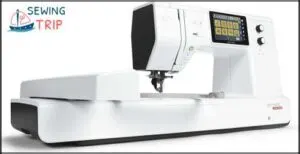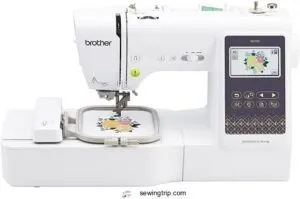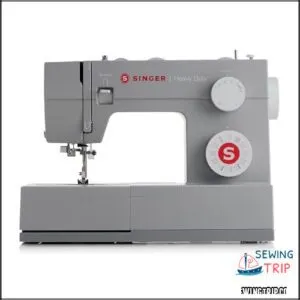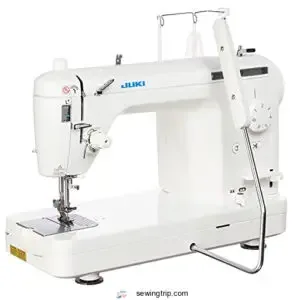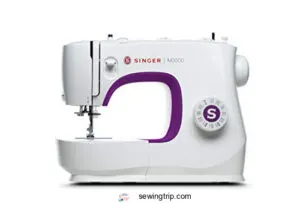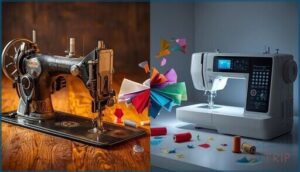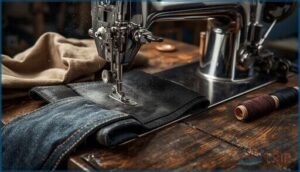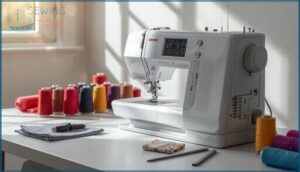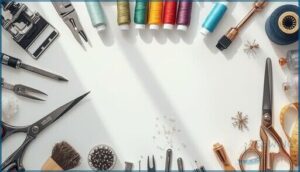This site is supported by our readers. We may earn a commission, at no cost to you, if you purchase through links.
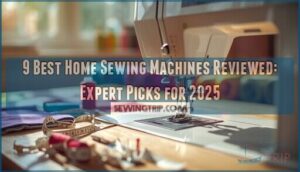
Your sewing machine doesn’t owe you simplicity—it owes you control. Whether you’re wrestling with denim hems or finessing silk facings, the right machine becomes an extension of your hands, not a battle with tangled thread and jammed bobbins.
Today’s best home sewing machines blend precision engineering with features that are easy to use, so beginners can master them and experienced sewers can tackle complex projects. From automatic needle threaders that eliminate squinting frustration to computerized stitch libraries that expand creative possibilities, these machines transform fabric into finished garments with professional results.
We’ve tested the top contenders across price points and specializations to help you find the perfect match for your sewing ambitions.
Table Of Contents
- Key Takeaways
- 9 Best Home Sewing Machines Reviewed
- 1. Brother Computerized Sewing and Quilting Machine
- 2. Janome Lovely Lilac Sewing Machine
- 3. Brother CS7000X Sewing and Quilting Machine
- 4. Singer Quantum Stylist Sewing Machine
- 5. Bernette B79 Sewing and Embroidery Machine
- 6. Brother SE700 Sewing Embroidery Machine
- 7. Heavy Duty Sewing Machine Kit
- 8. Juki TL-2000Qi Sewing Quilting Machine
- 9. Singer M3500 Sewing Machine with Kit
- Key Types of Home Sewing Machines
- Essential Features to Look For
- Choosing The Right Sewing Machine for You
- Must-Have Sewing Machine Accessories
- Tips for Maintaining Your Sewing Machine
- Frequently Asked Questions (FAQs)
- Conclusion
Key Takeaways
- The best home sewing machines balance precision engineering with user-friendly features like automatic needle threaders and computerized stitch libraries, transforming ambitious projects from intimidating challenges into achievable craftsmanship regardless of your skill level.
- Machine selection hinges on matching capabilities to your actual projects—beginners need simple reliability with 20-50 stitches and drop-in bobbins, while quilters and embroiderers require large throat spaces and extensive workspace, and heavy-duty sewers demand metal frames with high-torque motors for thick fabrics.
- Regular maintenance dramatically extends machine lifespan and performance: clean your machine every 10-15 hours of use, oil moving parts every 5-10 hours, replace needles every 8-12 hours, and invest in annual professional servicing to reduce breakdowns by 60% and add 20-30% to your machine’s working life.
- Essential accessories like specialized presser feet, proper needle sizes matched to fabric weight, extension tables for quilting, and quality maintenance tools aren’t optional extras—they’re the difference between fighting your equipment and creating professional results efficiently.
9 Best Home Sewing Machines Reviewed
You’re not here to settle for mediocre tools that hold you back. You deserve machines that match your ambition, whether you’re stitching your first seam or tackling intricate quilting projects.
You deserve machines that match your ambition, not tools that hold you back from your creative vision
Here are nine home sewing machines that’ll give you the control and precision to create exactly what you envision.
1. Brother Computerized Sewing and Quilting Machine
You’re about to take charge of your sewing destiny with the Brother XR9550—a computerized sewing machine that puts 165 built-in stitches at your fingertips.
This quilting sewing machine excels in bobbin management with its drop-in system and automatic needle threader, cutting setup time dramatically.
Beginners love the user-friendly LCD display for fabric selection and thread tension adjustments, while the variable sewing speed (up to 850 stitches per minute) lets you master quilting techniques at your own pace.
At just over 10 pounds, it’s portable power.
Best For: Beginner to intermediate sewers who want a versatile machine for garment construction and quilting projects without the complexity or cost of professional-grade equipment.
- 165 built-in stitches with an easy-to-read LCD display give you tons of creative options for everything from basic hemming to decorative quilting.
- Automatic needle threader and drop-in bobbin system save you time and frustration, especially if you’re new to sewing.
- Lightweight at 10.1 pounds with a wide table attachment makes it portable enough to move around but stable enough for larger quilting projects.
- Build quality gets mixed reviews, with some users reporting needle breaks and durability concerns for heavy or frequent use.
- Not designed for commercial or industrial workloads—this is a home machine that may struggle with thick fabrics or continuous heavy-duty sewing.
- Warranty is void if used outside the US or with different voltage, limiting international use or flexibility for travelers.
2. Janome Lovely Lilac Sewing Machine
If you crave simplicity with real durability, the Janome Lovely Lilac delivers. This beginner sewing machine packs 15 built-in stitches and a front-loading bobbin system into a full metal frame—no flimsy plastic chassis here.
At $129, you’re getting a sewing machine for beginners that manages denim layers and quilting projects without breaking a sweat. Sewing machine reviews consistently rate it 4.6 out of 5 stars for reliability.
The included presser feet and 25-year warranty seal the deal, making Janome features shine for first-time sewists ready to master their craft.
Best For: Beginners and casual sewers who want a reliable, no-frills machine that can handle everything from garment repairs to quilting without the learning curve of complicated features.
- Heavy-duty metal frame gives you real durability at an entry-level price, so you’re not replacing it after a few months of use.
- 15 built-in stitches and adjustable settings let you tackle denim, home decor, and buttonholes without needing to upgrade right away.
- Front-loading bobbin system and lightweight design (under 12 pounds) make threading simple and portability actually feasible.
- The bright pink “Lovely Lilac” color looks cheap to some users and might not fit every sewing space aesthetic.
- Plastic spool pins feel flimsy compared to the otherwise solid metal construction, which is a weird cost-cutting choice.
- No needle positioning to the right and limited stitch width adjustment mean you’ll hit creative walls faster than with slightly pricier models.
3. Brother CS7000X Sewing and Quilting Machine
The Brother CS7000X flips the script on computerized sewing machines—70 built-in stitches, an LCD user interface, and 750 stitches-per-minute sewing speed put you in command. This beginner sewing machine masters eight layers of denim while staying quieter than older models, proving machine durability doesn’t sacrifice performance.
The included wide table and walking foot make quilting a breeze, and at $215, you’re getting serious accessory compatibility—10 presser feet, hard case, and a 25-year warranty on the body. Your projects just leveled up.
Best For: Beginners and intermediate sewers who want a versatile, affordable machine that handles everything from basic garments to quilting projects without the complexity of high-end models.
- 70 built-in stitches and 10 included feet give you tons of creative options right out of the box, plus the wide table makes quilting larger projects way easier.
- Punches through eight layers of denim at 750 stitches per minute while running quieter than older Brother models—solid performance for the price point.
- Strong warranty coverage with 25 years on the body and a $215 price tag that won’t break the bank, making it a smart investment for home sewers.
- The instruction manual is confusing according to most users, and you’re missing advanced features like automatic thread tension or a knee lifter that experienced sewers might want.
- The automatic needle threader tends to fail after the warranty period ends, which is frustrating since it’s one of the convenience features people buy this machine for.
- Not built for heavy-duty or industrial work—it’s a budget-class machine that can shimmy at high speeds and won’t hold up to constant professional use.
4. Singer Quantum Stylist Sewing Machine
The Singer Quantum Stylist 9960 crushes it with 600 built-in stitches and 1,172 stitch applications—your creative arsenal just expanded. This computerized sewing machine hits 850 stitches per minute with speed control that matches your rhythm, while the automatic thread cutter and needle threader slash prep time.
User satisfaction ratings sit at 4.7 out of 5 stars, backed by a 25-year warranty on the head. At $300–$500, it’s dominated market position in its class, attracting both rookies and veterans ready to command their craft.
Best For: Sewers who want serious creative range—whether you’re quilting, tackling home décor, or personalizing garments—and need a machine that keeps up with both beginners finding their stride and experienced users pushing boundaries.
- 600 built-in stitches and 1,172 applications give you nearly endless creative options, from basic construction to intricate decorative work.
- Hits 850 stitches per minute with adjustable speed control, plus automatic needle threader and thread cutter that save you frustrating setup time.
- Backed by a 25-year warranty on the head and strong user ratings (4.7/5 stars), showing it delivers reliable performance at a solid price point.
- Some users report the needle threader and feed dogs can be finicky, requiring patience to dial in properly.
- Stitch quality isn’t always consistent—a few buyers mention wonky results that need troubleshooting.
- Weighs nearly 15 pounds, making it a pain to move around if you’re not keeping it in one spot.
5. Bernette B79 Sewing and Embroidery Machine
The Bernette B79 combination sewing and embroidery machine puts 500 stitches and 208 embroidery designs at your fingertips through a crisp 5-inch touchscreen navigation system. You’ll command stitch width and length with multi-function knobs while the dual feed system powers through silk and denim without puckering.
The Stitch Designer unlocks unlimited patterns, and programmable foot control with back-kick function keeps your hands free.
Three embroidery hoops, automatic hoop detection, and 1,000 stitches per minute transform your boldest visions into reality—no compromises.
Best For: Sewers and embroiderers who want professional-level speed and creative freedom without switching between machines, from detailed monogramming to multi-layer quilting projects.
- Blazing 1,000 stitches per minute sewing speed and 850 for embroidery means you finish projects faster without sacrificing stitch quality.
- Dual feed system handles everything from delicate silk to thick denim layers with consistent results and zero puckering.
- 500 stitches plus 208 embroidery designs with touchscreen editing give you endless creative combinations right out of the box.
- Menu navigation can be confusing for beginners despite the touchscreen, often requiring extra research beyond the basic manual.
- Heavy 47-pound weight makes it tough to move around or store if you’re working in tight spaces.
- Specialized accessories and replacement parts aren’t always easy to track down when you need them.
6. Brother SE700 Sewing Embroidery Machine
The Brother SE700 combination sewing and embroidery machine delivers 103 sewing stitches and 135 embroidery designs through wireless connectivity that transfers patterns straight from your phone. You’ll command 710 stitches per minute in sewing mode, while the 3.7-inch touchscreen user interface and automatic thread cutter eliminate tedious manual adjustments.
The 4″ x 4″ embroidery field manages monograms and detailed motifs with precision. Machine durability backs this power—25-year limited warranty on the chassis plus lifetime technical support.
At $499.99, you’re seizing professional-grade computerized sewing machine features without the premium price tag.
Best For: Crafters and sewers who want to switch between everyday garment projects and custom embroidery without buying separate machines.
- Wireless design transfer from your phone through the Artspira app means you can create and send patterns without dealing with USB drives or cables.
- Fast 710 stitches per minute for sewing projects, plus automatic needle threading and thread cutting save you time on repetitive tasks.
- Strong warranty coverage with 25 years on the chassis and lifetime technical support gives you peace of mind for long-term use.
- The 4″ x 4″ embroidery area limits you to smaller designs, so large-scale embroidery projects won’t work.
- Some users report the machine feels less sturdy than expected, with occasional wobbling or squeaking during operation.
- You’ll need to buy extra supplies like stabilizer and specialty thread, plus potentially subscribe to design software for expanded pattern options.
7. Heavy Duty Sewing Machine Kit
Punching through canvas, upholstery, and multiple denim layers demands enhanced piercing power—that’s where the Singer 4432 Heavy Duty Sewing Machine Kit stands out.
You’ll access 110 stitch applications backed by a full metal frame built for machine durability tests that matter. This heavy-duty sewing machine handles thick fabrics at 1,100 stitches per minute, while the top drop-in bobbin and automatic needle threader keep your workflow efficient.
At $179.99 with six presser feet included, you’re equipped for serious heavy fabric projects without compromise.
Best For: Sewers tackling heavy-duty projects like denim, canvas, and upholstery who need a durable machine that can handle multiple layers without slowing down.
- Enhanced piercing power with a strong motor and full metal frame lets you sew through thick fabrics and multiple layers at 1,100 stitches per minute.
- 110 stitch applications give you plenty of versatility for garments, bags, home decor, and other creative projects.
- Complete accessory kit includes six presser feet, extra bobbins, needles, and tools—everything you need to start sewing right away at $179.99.
- Some users report the automatic needle threader doesn’t work reliably, which can be frustrating if you thread often.
- Stitching quality issues have been mentioned by certain customers, suggesting inconsistent performance in some units.
- The upright spool pin may cause thread to jump or wrap around the pin, requiring adjustments or workarounds during use.
8. Juki TL-2000Qi Sewing Quilting Machine
When precision quilting techniques meet industrial-grade machine durability, you command the workspace—that’s the advantage of the Juki TL-2000Qi. This sewing machine for quilting delivers 1,500 stitches per minute with straight-stitch excellence, while its aluminum die-cast construction minimizes vibration during heavy fabric handling.
You’ll appreciate the automatic thread management and knee lifter that free your hands for intricate work.
At approximately $700-$800, this computerized sewing machine transforms king-size quilts from intimidating projects into achievable craftsmanship, supported by an extension table that expands your sewing speed capabilities.
Best For: Serious quilters and sewists who need industrial-strength performance for heavy fabrics and large projects like king-size quilts, but only require straight-stitch capability.
- Industrial-grade build with 1,500 stitches per minute and aluminum die-cast construction that handles everything from delicate quilting to thick leather with minimal vibration.
- Generous 23-inch work area with extension table, knee lifter, and LED lighting that make tackling oversized projects efficient and comfortable.
- Automatic thread cutter and needle threader save time on repetitive tasks, while the adjustable presser foot pressure adapts to different fabric weights seamlessly.
- Straight-stitch only machine means no decorative or zigzag stitches, which limits versatility for general sewing projects.
- Automatic threader can be finicky and may require adjustment, and the bobbin placement is awkward for users with limited hand mobility or arthritis.
- Heavy 25-pound weight makes it difficult to move or unpack, and international users need a voltage converter for non-110V countries.
9. Singer M3500 Sewing Machine with Kit
When versatility meets affordability in home sewing, you’re looking at the Singer M3500—a powerhouse that rivals the Singer M1000 while delivering 110 stitch applications for diverse sewing projects.
This affordable sewing machine ranks among the best beginner sewing machines at $149-$199, backed by a metal frame and extensive sewing kit including four presser feet and maintenance tools.
You’ll tackle everything from lightweight knits to denim with adjustable stitch width up to 5mm, though proper bobbin installation matters—about 15% of users report jams when rushed through setup for home use.
Best For: Beginners and budget-conscious sewers who want a versatile machine with plenty of stitch options without breaking the bank.
- 110 stitch applications give you tons of creative flexibility for everything from basic repairs to decorative projects, all at an entry-level price point.
- The automatic needle threader and LED lighting make setup and detailed work much easier, especially if you’re new to sewing or working in dim spaces.
- Durable metal frame construction means this affordable machine won’t wobble or wear out quickly, even with regular use across different fabric types.
- About 15% of users experience bobbin jamming issues, usually traced back to improper installation during the initial learning curve.
- The included manual is pretty basic, so you’ll likely need to look up online videos for troubleshooting and advanced techniques.
- Not built for heavy-duty or commercial work—it’s a solid home machine but won’t handle constant use on thick upholstery or industrial projects.
Key Types of Home Sewing Machines
You can’t master your craft if you’re working with the wrong tool. Each type of sewing machine brings different strengths to your workspace, from straightforward mechanical reliability to sophisticated computerized precision.
Let’s break down the main categories so you can pinpoint exactly what you need for the projects you want to conquer.
Mechanical Vs. Computerized Machines
You’re at a crossroads here: mechanical machines or computerized sewing machines? Mechanical sewing machine options deliver straightforward reliability and lower repair costs—perfect if you’ve got solid user skill and don’t mind manual adjustments.
Computerized sewing machine options dominate market share with automation level that cranks up stitch precision through hundreds of built-in stitches. For beginners, mechanical sewing machines are often easier to use.
The computerized vs mechanical machines debate ultimately hinges on whether you value simplicity or sophisticated control.
Sergers and Overlock Machines
While computerized and mechanical machines handle standard seams, sergers and overlock machines dominate fabric finishing with specialized techniques. These heavy-duty sewing machines deliver professional edges at industrial speeds—North America’s adoption jumped 7.1% recently. Thread management gets complex here:
- Sergers cut, sew, and finish edges simultaneously using 3-5 threads
- Overlock machines focus purely on seam reinforcement with 3-4 threads
- Denim sewing machines benefit from overlock durability on thick fabrics
- Rolled hems and flatlock stitches expand your creative range
- Proper serger maintenance extends lifespans beyond 40 years
Sewing efficiency skyrockets once you master overlock techniques. Understanding the serger vs overlock differences is essential for selecting the right machine for your needs.
Embroidery and Quilting Machines
Embroidery machines and quilting machines transform creative visions into fabric reality—the global market hit $1.39 billion in 2024. Computerized models dominate, with 3.2 million units sold, offering 100-600 stitches, touchscreen controls, and quilting software integration.
Thread tension and stitch regulation technology guarantee precision, while machine learning features in Wi-Fi-enabled models let you customize embroidery capabilities remotely.
Fabric selection matters less when your equipment manages everything from delicate silks to dense batting.
Heavy-Duty and Industrial Machines
When denim, leather, or canvas push standard machines to their limits, heavy-duty sewing machines step up with metal frames and high-torque motors built for continuous operation. Industrial models handle thick fabric layers at speeds reaching 5,000 stitches per minute—machines engineered for automotive upholstery and outdoor gear production.
- Industrial sewing machines deliver speeds up to 5,000 stitches per minute
- Heavy duty motors range from 1,700 to 3,450 RPM for demanding projects
- Machine durability stems from strong metal construction and self-oiling mechanisms
- Fabric handling capabilities extend to multiple thick layers without compromising precision
- Sewing automation features enable programmable stitching for repeatable accuracy
Essential Features to Look For
Not all sewing machines are created equal, and knowing what features actually matter will save you from buyer’s remorse. The right combination of capabilities can mean the difference between a machine that grows with your skills and one that collects dust in your closet.
Here’s what separates the workhorses from the frustration machines.
Built-in Stitch Options and Applications
Your machine’s built-in stitches release creative freedom and technical precision. Home models generally offer 12 to 200+ stitch options—from essential lockstitches to decorative embellishments. This stitch variety directly impacts fabric compatibility and your sewing techniques. Look for adjustable stitch length and thread tension controls; they’re game-changers for stitch customization across different materials.
| Stitch Type | Primary Application |
|---|---|
| Lockstitch | Strong seams, garment construction |
| Zigzag | Stretch fabrics, edge finishing |
| Stretch Stitch | Knitwear, activewear elasticity |
| Decorative | Embellishment, creative projects |
Automatic Needle Threading and Buttonholes
Threading mechanisms can make or break your sewing efficiency—automatic needle threading cuts setup time to under a second, while one-step buttonhole functions guarantee uniform results every time. Modern machines like the Singer 4423 combine both features with impressive speed.
- Automatic needle threader: Eliminates frustration and aids accessibility for users with vision or dexterity challenges
- Buttonhole styles: One-step automation produces consistent sizing across multi-button garments
- Thread management: Proper needle technology and positioning prevent mechanism damage and extend longevity
Bobbin Type and Ease of Use
Your choice between drop-in and front-loading bobbins shapes every sewing session. Drop-in designs let you monitor thread levels through clear covers—perfect for beginners. Front-loading options offer enhanced thread tension control for specialized techniques like shirring, though they demand careful handling.
| Bobbin Type | Key Advantage |
|---|---|
| Drop-in bobbin | Quick insertion, visible thread supply |
| Front-loading bobbin | Precise tension adjustment for elastics |
| Class 15 (A Style) | Universal compatibility across major brands |
Most home machines use Class 15 bobbins (20.6mm diameter), while heavy-duty models need larger M-Style options. Metal bobbins deliver consistent performance for high-speed work; plastic versions suit everyday projects. Wrong bobbin materials create tension nightmares and jams—always match your machine’s specifications for ideal sewing efficiency and user experience.
Speed Control and Stitch Adjustment
Speed regulation transforms shaky stitching into polished seams. You’ll find sliding levers, push buttons, or tortoise-and-hare symbols controlling your maximum pace—essential when mastering curves or wrestling thick denim.
Stitch length dials (0.0 to 5.0mm) and width controls (up to 5mm for zigzags) let you fine-tune fabric tension and thread control.
Computerized machines store your settings for sewing efficiency; mechanical models demand manual precision but reward you with unbreakable durability.
Machine Weight and Size
Portability factors clash with stability benefits in every sewing room. Machines under 10 pounds let you chase sewing classes and weekend retreats, but they’ll dance across your table when tackling denim.
Those 20-pound workhorses anchor your workspace impact for material handling thick upholstery—though storage concerns multiply.
Weigh your workspace against mobility: compact home use demands different muscle than dedicated studio sewing.
Choosing The Right Sewing Machine for You
Your project goals and skill level should drive your machine choice—not the other way around. Whether you’re stitching your first seam or tackling thick upholstery, the right machine gives you freedom to create without fighting your equipment.
Let’s match you with a machine that actually fits your work.
Best for Beginners
You don’t need years of experience to tackle your first project—not with today’s beginner-friendly sewing machines. The best sewing machine for beginners balances ease of use with stitch simplicity, usually offering 20 to 50 options without overwhelming you.
Budget options like entry-level sewing machines under $200 deliver automatic needle threaders and drop-in bobbins, flattening the learning curve. Clear user manuals seal the deal for beginner sewers ready to create.
Best for Quilting and Embroidery
Quilting techniques and embroidery designs demand workspace you can actually maneuver. Machines like the Brother SE1900, with its 5″x7″ embroidery field and 138 built-in embroidery designs, give you creative freedom at 850 stitches per minute.
Premium quilting machines excel with:
- Large throat spaces (12+ inches) for full-size quilts
- Automatic thread management and tension control
- Adjustable stitch options for intricate fabric selection
- USB connectivity for importing custom embroidery designs
Best for Heavy Fabrics (Denim, Leather)
Heavy fabric sewing machines powered by 90W to 110W motors give you serious needle penetration through multiple denim layers and leather. The Singer Heavy Duty 4452 tears through thick material handling at 1,100 stitches per minute, while the Juki TL-2010Q dominates industrial sewing machines territory with compound feed systems.
You’ll need metal frames, adjustable presser feet, and needles up to 110/18 for bulletproof denim stitching and leather crafting.
Budget-Friendly Vs. High-End Options
Budget sewing machines ($80–$250) deliver solid home sewing for beginners with 20–50 stitches and basic automation—affordable sewing machines that won’t break the bank.
High-end options ($1,499–$5,000) offer cost efficiency through durability, professional sewing quality, and sophisticated user interface features like touchscreens.
Your price comparison boils down to this: entry-level for learning, premium for machine durability and long-term mastery.
Must-Have Sewing Machine Accessories
Your machine is just the beginning—the right accessories will maximize its full potential and make every project faster, cleaner, and more professional. From specialized presser feet that handle tricky fabrics to the maintenance tools that keep your machine running smoothly for years, these add-ons aren’t optional if you’re serious about your craft.
Here’s what you actually need to build a complete sewing setup that works as hard as you do.
Presser Feet and Extension Tables
Your machine’s presser feet and extension tables release serious creative power—these aren’t just nice-to-haves. The right presser foot types give you fabric control systems that prevent skipped stitches and wandering seams, while extension tables transform quilting accessories into precision tools. Here’s what you need:
- Low shank vs. high shank feet – Match your machine’s compatibility first
- Zipper and blind hem feet – Essential specialized options beyond all-purpose
- Adjustable presser foot pressure – Critical for varied fabric thicknesses
- Quilting extension tables – Increase workspace and reduce shoulder strain
- Teflon-coated feet – Perfect for leather and vinyl projects
Bobbins, Threads, and Needles
Your sewing notions arsenal starts here: pair Class 15 or drop-in bobbin types with thread tension that actually works.
Needle sizes from 70/10 to 90/14 determine fabric compatibility—higher numbers tackle heavyweight fabrics, lower ones handle delicates. Match thread weight to needle size: 50-60 wt needs 70/10 or 80/12, while 30-40 wt demands 80/12 or 90/14.
Replace needles every eight hours to dodge skipped stitches and thread breakage.
Maintenance Tools and Supplies
You’ll need lint brushes to sweep away fabric dust and a bottle of clear machine oil—one drop every eight hours keeps moving parts friction-free. Screwdrivers disassemble your needle plate for deep cleaning, while thread cutters handle precise snips during sewing machine maintenance.
Soft cloths and cotton swabs tackle delicate areas without scratching, and covering your machine between projects cuts dust accumulation dramatically.
Useful Add-ons for Versatility
Presser feet access new creative territory—buttonhole and blind hem attachments reduce manual error by up to 90%, while walking feet deliver consistent fabric feeding across multiple layers. Extension tables expand your workspace by 40%, and twin needles create parallel decorative seams in half the time.
- Quilting guides boost seam accuracy to 95% for straight-line precision
- Embroidery hoops guarantee uniform stitching and minimize thread breakage
- Edge finishing tools like rolled hem feet accelerate lightweight fabric hems by 60%
Tips for Maintaining Your Sewing Machine
Your sewing machine won’t serve you well if you don’t take care of it—plain and simple. Regular maintenance keeps your stitches clean, your machine running smoothly, and saves you from costly repairs down the road.
Here’s what you need to know to keep your workhorse in fighting shape for years to come.
Cleaning and Oiling for Longevity
Think of your machine’s internal frame like your car’s engine—it won’t run smoothly without proper care. A consistent cleaning schedule after every 10–15 hours of use removes lint buildup from the bobbin case and feed dogs, keeping your durable construction humming. Machine lubrication with 1–2 drops of quality oil every 5–10 hours prevents tension failures and extends lifespan up to 20 years.
Here’s your maintenance roadmap:
| Task | Frequency | Impact |
|---|---|---|
| Quick brush-down | After each project | Prevents slowdown |
| Deep cleaning | Every 4–8 weeks (daily use) | Reduces jams 50% |
| Oil change intervals | Every 5–10 hours | Adds 20–30% lifespan |
| Needle replacement | Every 8–12 hours | Prevents skipped stitches |
| Professional servicing | Annual or biannual | 60% fewer breakdowns |
Run your machine for several minutes post-oiling to distribute lubricant across moving parts. Neglect turns oil into abrasive gunk within a year, cutting machine longevity by 40%.
Master these sewing maintenance longevity tips, and you’ll keep stitch consistency sharp while minimizing sewing machine repair costs down the road.
Troubleshooting Common Issues
When your machine rebels mid-project, you’re not helpless—most hiccups have quick fixes. Thread tension adjustments solve 70% of bunching issues, while fresh needles eliminate skipped stitches in 80% of cases.
- Thread bunching: Rethread completely and check bobbin problems (47% of feeding defects)
- Needle issues: Replace every 8–16 hours to prevent breakage
- Feed errors: Clean clogged feed dogs after 10 hours of use
- Motor malfunctions: Inspect foot pedal wiring (37% of slow operation)
- Uneven stitches: Adjust presser foot pressure for fabric thickness
Master these troubleshooting moves, and you’ll restore sewing machine performance without expensive machine repair calls.
When to Seek Professional Repairs
Grinding noises or electrical sparking signal you’ve hit repair-not-DIY territory. When troubleshooting fails to fix timing issues or motor problems, professional maintenance becomes essential—typical sewing machine repairs cost $50–$75, but complex fixes approach $100.
If repair cost analysis reveals expenses exceeding half your machine’s value, replacement wins. Trust machine failure signs like persistent skipped stitches or unresponsive controls; sewing machine manuals can’t fix everything.
Storing and Transporting Your Machine
Climate control matters more than you think—humidity above 60% rusts metal frame components within months, while freezing temps crack plastic housings. Store your machine in a climate-controlled space, away from basements or garages.
Invest in protective cases for transport; hard shells offer 90% better impact protection than fabric bags.
Machine weight affects handling—models over 15 lbs double your drop risk, so use proper lifting techniques and carrying cases with grips.
Frequently Asked Questions (FAQs)
How often should I replace my sewing machine needle?
Swap your needle every 6 to 8 hours of stitching—or after each project involving denim or leather. Skipped stitches, popping sounds, and fabric snags signal it’s time for replacement indicator signs.
Can I sew leather with a home sewing machine?
You can sew leather up to 5 mm thick on heavy-duty sewing machines with proper leather needles, upholstery thread, and non-stick presser feet.
Use longer stitch length (5 mm) and slow speeds for best results.
What maintenance routines should I follow?
Keep your machine sharp with routine cleaning after every few sessions.
Ensure regular oil changes every three to four bobbin changes.
Practice needle care by replacing them every six to eight hours of use.
Are there eco-friendly sewing machine options available?
Yes—brands like Janome and JUKI now build home sewing machines with recycled components, energy-efficient motors, and sustainable manufacturing practices.
These eco-friendly materials and green technology reduce your environmental footprint while delivering reliable, durable construction.
How do I troubleshoot tension problems?
Ironically, most thread tension problems vanish when you rethread everything—65% of cases stem from improper threading.
Check your bobbin issues, match thread weights, and adjust tension dials incrementally.
Clean lint buildup affecting stitch quality regularly.
How loud are home sewing machines during operation?
Most home sewing machines hover around 60 decibels during operation—think normal conversation volume. Heavy-duty models can spike to 75 decibels at top speed, while computerized machines with vibration control usually run quieter than mechanical counterparts.
Do I need a special table for sewing?
You don’t need one, but a solid sewing surface changes the game.
Table ergonomics matter: proper height reduces strain, vibration reduction keeps stitches accurate, and workspace organization with extension tables expands your work area considerably.
Can beginners learn to sew without taking classes?
Absolutely. Most sewing novices master foundational skills through online tutorials and beginner-friendly sewing machines within weeks, though self-teaching effectiveness varies.
Resource quality and motivation strategies matter more than formal sewing classes for committed learners.
Whats the average lifespan of a sewing machine?
Your machine’s longevity hinges on maintenance impact, usage intensity, and sewing machine build quality. Mechanical models usually run 15–30 years, while computerized machines average 7–15 years.
Brand durability and repair costs vary considerably across sewing machine brands.
Conclusion
The right machine is your passport to creative freedom—no more surrendering to limitations or settling for hand-finished seams when precision matters. Among the best home sewing machines, you’ll find tools that match your ambition, whether you’re piecing quilts or tailoring jackets.
Choose based on what you’ll actually create, not aspirational projects gathering dust. Your fabric, your vision, your rules. Now stop researching and start sewing—mastery lives in motion, not manuals.

